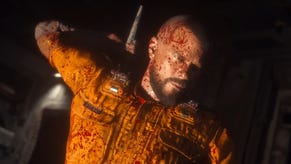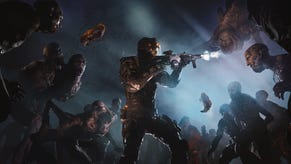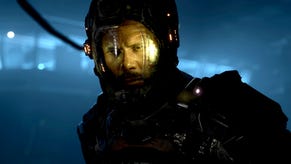The Callisto Protocol mixes new tricks with the old-school "style" of Glen Schofield
"I know there's my style in there, so I've consciously tried to change things up."
The Callisto Protocol showed some gameplay to the public for the first time at Gamescom this year, with about three minutes of footage highlighting a bit of combat, a bit of stealth, and a slip-n-slide finish that ends with a bit of a crunch. Behind closed doors at the show, however, we saw a much longer version - albeit with the same stomach-churning finale - and had time to speak with the game's director and studio head Glen Schofield.
Things begin with a jump - a scare as you open a door that then leads into a bit of one-on-one combat with one of The Callisto Protocol's more standard enemies. The twist here is that enemies in The Callisto Protocol can mutate. After you engage them in combat some tentacles will start spurting out of their torso. Shooting or otherwise battering them in the tentacles will put them down faster, the mutation acting as a kind of weak spot, but miss your fairly short window and those enemies will evolve, gruesomely, into much more resilient, aggressive opposition. Dodging becomes important - there was a lot of ducking, diving, dipping and dodging in this demo - while you club away at them with a kind of riot baton in melee, although if more than one mutated enemy starts coming at you, you'll struggle.
"I think our combat is much more complex than we've made before," Schofield says, as opposed to how things were with the likes of Dead Space, this game's spiritual predecessor and the series Schofield created. "Especially with a sort of survival horror game - you've got a bunch of different weapons. I've always believed that survival horror doesn't mean you would just have one bullet, right? Survival horror, I [think] means: I've got a clip, but I still can't take them all out."
Schofield describes your options as "a pretty extensive arsenal" here. "You've got stealth now, where you're using a shiv to get behind them and take out a couple of them - but they're gonna notice you after a while." And then there's the flexibility of how you upgrade your weapons, a system Schofield describes as a kind of "skill tree - you're never going to be able to fill the skill tree unless you play twice."
After the initial skirmish, for instance, it was time for a bit of rummaging around for supplies in a nearby room - Schofield says there are a lot of "beta paths that not everybody is catching on the first playthrough… some of them are a little bit longer. Some of them are for searching for stuff. Some of them just fill in the blanks a little bit. We have one that has a pretty grotesque shower" - and then a spot of that upgrading.
The Callisto Protocol has 3D printers dotted around the place for this, so you'll gather supplies from cupboards and boxes and dead bodies to spend here on upgrades. In this case the baton was upgraded with an electrical stun, as was your Grip Gun, a contraption that gives you a kind of force-pull capability, letting you pick up items and enemies and lob them about the place.
Schofield enjoys talking about your options here. "It's cool, because sometimes they hit the wall and they'll be dismembered, so there's just a part of one hanging there. You can send them into a wood chipper, you can send them into giant fans and around them. You can also pick them up and use them as a meat shield - but watch out! Because the guy shooting is going to cut off the legs and arms. So they're not going to be much of a meat shield after a while."

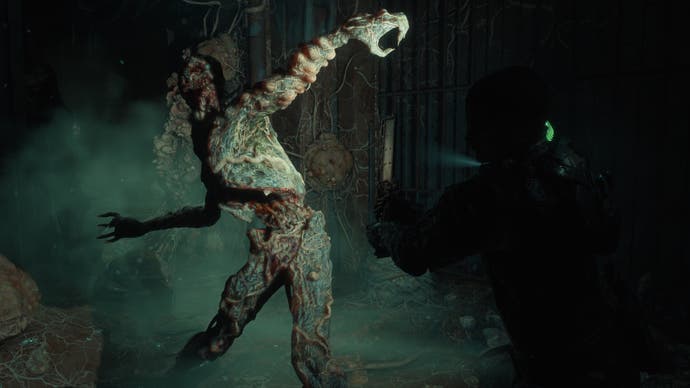
After the upgrades came a kind of miniature bossfight in a control room (full of industrial consoles and big vats of green goo - giving some Batman villain interior design staples) against a particularly horrible, four-legged mutation that could turn invisible, amongst a number of more basic, but rapidly mutating enemies, concluding with a Triangle button-mashing quick-time-event.
"You're gonna want to probably go for the closest one, right?" Schofield says, talking about how these types of scenarios will play out in less scripted situations than this demo. "Try and take him out as soon as possible. Now the other thing you can do is, when they're on the ground, let's say you've shot them, you stomp on them and they will die, and those tentacles won't come out. So yeah, you gotta watch out, you may want to take out the spitting one who's probably behind them. Because he's got really good accuracy. And he's not shooting out, like, bullets or anything. He's shooting out a giant parasite. So it lands on you. You got to kill him…"
Schofield is at his most animated when talking about this, the nuts and bolts of action horror, which is understandable given his history. There are obvious - very obvious - similarities between The Callisto Protocol and Dead Space, but also with some of his Call of Duty games, the likes of Black Ops and Modern Warfare 3 that were known for their rollercoaster-like style. The Callisto Protocol absolutely has this, even beyond the more literal example of that sewer-based water slide that concluded both the public demo and this one. It's a game about moving from one curated, deliberately positioned terror to the next as smoothly as possible. There's an argument that this is somewhat old-school, given the way triple-A games have evolved over the last decade. He might call it cinematic.
"You know, look, I have a style," Schoefield says, "and it's evolved over 14 years, but there's still similarities in a way." He talks about getting the balance right when trying to bring that through in the game. "We're starting to use different sounds, we're changing the way we do 'stingers'... like one might be crazy violent, or something like that - if it fits."
"I know there's my style in there. So I've consciously tried to change things up a little bit. There are other times like the stomp," as in, the finisher move you can do on downed enemies. "I'm like, why can't I have a stomp? You know, why can't I have dismemberment? Every other game since our game [Dead Space] put dismemberment in. So yeah - at first they said "nothing from Dead Space, nothing!" And then as the game went on, I'm like, why am I not embracing it a little bit?
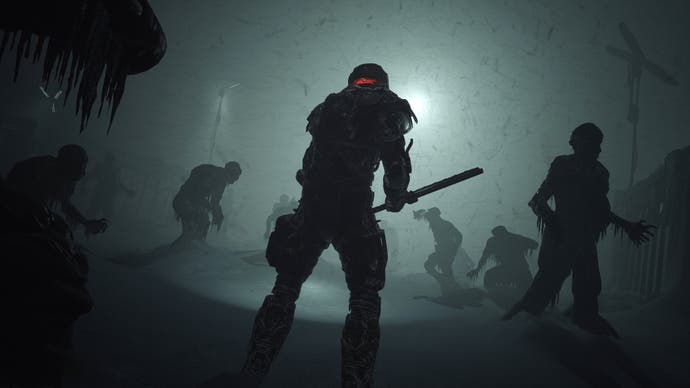
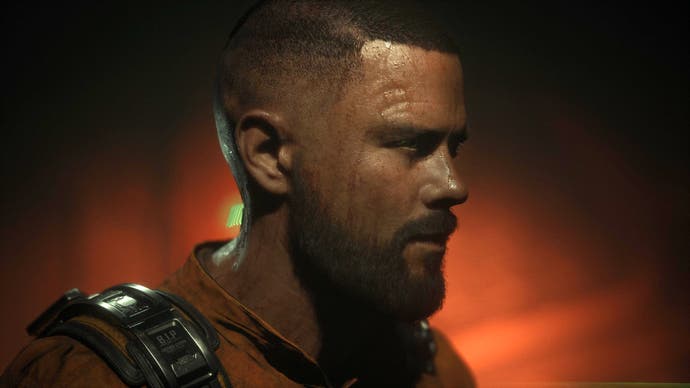
"There's been a lot of similarities that people have been talking about. But I think if you play the game, you'll feel it's different. And we've got the storyline running through it, we've got other characters you're talking to, we have a follower for a while, and the story - the movies are anywhere from 45 minutes to an hour long in the game, so there's a lot of story to be told…"
The obvious question is whether Schofield feels a sense of competition, given Dead Space happens to be getting a remaster of its own, just as The Callisto Protocol nears launch. "You know, I was making Modern Warfare 3," Schoefield says, "at the same time, Battlefield 3 was coming out. Last time I made Dead Space, Left for Dead was coming out. And they both had severed arms on the front. And they both had "Dead" in it. And they were both from EA!" (The now-closed EA Partners handled Left 4 Dead's publishing, despite it being a Valve game, along with things like The Orange Box.)
"I went to EA and I'm like: what are you thinking?! And they were like: "well, we're putting 'em both out." So every game I make has competition. So I stopped worrying about it. I just focus on making the best game, the vision of the game that we have."
Back to the demo in action, and we've moved on to an area that almost seems like a garden, albeit with the kind of central, spinning cluster of meat-grinding pillars that you'll have spotted in the public trailer. We pick up enemies and lob them into the grinder, we kill a few with stealth, we use a few as meat shields, we stomp some heads, and we throw more enemies into the grinder to bring the combat to an end - at which point, after a beat, its sprinklers start up, spurting out a rain of blood as if to water the plants. A kind of punchline from the setup that came just before.
.png?width=690&quality=75&format=jpg&auto=webp)
There's an obvious thread of black humour running through The Callisto Protocol - the kind that Sam Raimi has talked about elsewhere, with his famous quote about how the two genres blend.
"Comedy and horror, they're strange cousins. When I'm setting up a suspense sequence, I find it very similar to setting up a joke. They're similar in terms of construction, setup and payoff. There's this built-up anticipation from the audience about what may lie beyond the door, or what the bartender in the joke may say. A scream of horror when the creature leaps out is very similar to the scream of laughter from an unexpected punchline. A scream and a laugh are both involuntary reactions. And also, for me at least, I'll often titter when I'm terrified, because it's the only way I can deal with horror movie moments. I'm a big coward."
Schofield was keen not to go overboard with this - although part of me wonders if his answer is a matter of perception, given the way fans of one genre can often react upon the mention of bringing in aspects from another. "He [the main character] has some lines here and there. You got to be careful because we had too many of those lines at one point, right… I don't know if I want 'funny' in my game… maybe a little sarcastic or something like that. Because you don't want [a situation where the player thinks]: "Oh, he just said another line. Here comes a scare." You don't want to set up any patterns in a horror game. None. Or if you do set a pattern, you want to screw with that pattern, like ah! We didn't put anything there!"
"It's hard. It's hard engineering. It comes from the gut. Right? It really does. It's like, okay, I feel like it's time for a scare [but there isn't one]. But then maybe next time I scare you within two seconds. So no rules."

Schofield's greatest emphasis however, when it comes to the kind of "horror engineering" that comes up both here and in a quick presentation before the demo, is on sound and music, particularly with how the team at developer Striking Distance has tried to stop the genre - or indeed the series, where a lot of players go into this game knowing exactly what they want, and probably what they'll get - from getting stale.
"What we've had to do is find new things in music, new trends. We use what's called the Apprehension Engine. It's this crazy instrument that just makes weird sounds. We picked it up from Hollywood. We don't know any other game that's ever used it because it's a strange machine… the first I heard was in Sicario 2 believe it or not, so the music's playing, it's a little tense, a little low, and then all of a sudden we go nnwwooaaarr," he says, making a kind of deep klaxon noise.
"And you're like - what was that?! It makes your hair stand up on your arms, you know?" He elaborates again later on, when asked about combating staleness for those overfamiliar fans. "The way that we can combat that is with the music - so I've got very tense music, it's just sort of steady, then we'll scare the hell out of you in the middle of it, because you're not expecting it. "Or," he says, "what we're trying to do is in the beginning levels of the game, do stuff like scare you at a door, so from then on you're a little worried about the door," a reminder of this demo's opening. "You come to a door and you build up the music, build it, build it, build it, they open the door and there's nothing."
These might be new tricks - or maybe, new twists on old ones - but there's still that slightly old-school sense to The Callisto Protocol. Part of it is the rollercoaster-like linearity, part of which, Schofield says, "is because I want to tell the story, and it's hard to tell a story when you're going in all different directions and doing different things."
It probably also comes back to Schofield's style, and to his attitude as a whole. Over the weekend he tweeted about Striking Distance's culture, which seemed a perfect example of the culture leading to crunch. "We [are] working six-seven days a week, nobody's forcing us. Exhausted, tired, covid, but we're working. Bugs, glitches, perf fixes. One last pass through audio. 12-15 hour days. This is gaming. Hard work. Lunch, dinner, working. You do it cause ya luv it."
He subsequently deleted that tweet and posted an apology, saying it was "wrong" to emphasise the team's "hard work" over their "creativity." These attitudes are probably all related, and it leads to a game that's somewhat hard to pin down as a result. The Callisto Protocol feels like a game from 2010, in many ways. In many ways that makes it seem like a kind of blast from the past - linear story, cutscenes, quick-time-events and high production value set-pieces - an enjoyably guided tour through a hall of horrors. But there are a few things from that era of games that are far better left behind.





